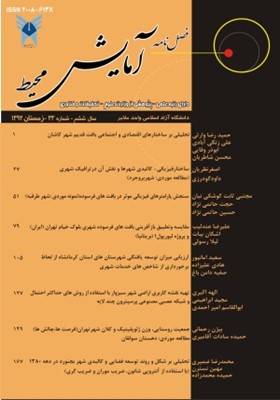تحلیلی بر ساختارهای اقتصادی و اجتماعی بافت قدیم شهر کاشان
محورهای موضوعی : آمایش محیطحمید رضا وارثی 1 , علی زنگی آبادی 2 , ابوذر وفایی 3 * , محسن شاطریان 4
1 - (دانشیار گروه جغرافیا و برنامه ریزی شهری دانشگاه اصفهان )
2 - (دانشیار گروه جغرافیا و برنامه ریزی شهری دانشگاه اصفهان)
3 - (کارشناس ارشد رشته جغرافیا و برنامه ریزی شهری دانشگاه اصفهان)
4 - (دانشیار دانشگاه کاشان)
کلید واژه: بافت قدیم, کاشان, احیاء, ساختار اقتصادی و اجتماعی,
چکیده مقاله :
بافت تاریخی و با ارزش کاشان با توان بالقوه ی تاریخی، فرهنگی و کالبدی نهفته در درون خود بهترین نشانه ی هویت شهری کاشان محسوب شده، به دلیل ویژگی های ساختاری خاص در گذشته موجب وحدت فضایی شهر می گردد. این محدوده زمانی با محدوده ی کل شهر قدیم یکی بود اما بر اثر تحولات و تغییراتی که در طول زمان رخ داد، شهر به تدریج گسترش یافت و آنچه که به عنوان بافت تاریخی هسته ی مهم مسکونی، تجاری و ... بود به تدریج در حاشیه قرار گرفت. توسعه و گسترش شهر و ایجاد هسته های جمعیتی حاشیه ی شهر، ساخت متمرکز و متراکم بافت قدیم را تبدیل به بافت پراکنده ی چند هسته ای نموده که از نظم ساختاری خاصی پیروی نمی کرد. رفته رفته میل به فرار از بافت قدیم در دل ساکنین بومی بافت جان گرفت و به تدریج این نواحی از بافت به علت عدم موفقیت در جذب و نگهداشت ساکنین در درون خود به علت کمبود خدمات رسانی هم به لحاظ کالبدی و هم از نظر فرهنگی، اجتماعی و اقتصادی رو به فرسودگی نهاد. تأکید همزمان بر احیای کالبدی و احیای سازمان اجتماعی و اقتصادی بافت قدیم، شناخت عناصر مختلف بافت قدیم شهر کاشان و تطبیق آن با ساختار و نیاز های بافتجدید و به طور کلی ارائه ی راه حل هایی به منظور بهبود بهینه سازی توسعه ی شهری در راستای ایجاد یک منطقه ی فعال و زنده ی شهری از لحاظ کالبدی، اقتصادی، اجتماعی و فرهنگی جهت تأمین مطلوب نیازها و خواسته های شهروندان از اهداف مهم این پژوهش به شمار می رود. جهت بررسی و تبیین موضوع تحقیق ترکیبی از روش های توصیفی، تحلیلی و پیمایشی استفاده شده است. نتایج پژوهش نشان می دهد عدم تطبیق بافت قدیم شهر با نیازهای روز ساکنین، ناتوانی در خدمت رسانی به خصوص ورود اتومبیل به درون بافت که از جدید ترین نیازهای ساکنین بوده به همراه عدم توانایی مالی ساکنین بافت جهت احیاء مجدد و کم شدن احساس تعلق به بافت به ویژه در بین جوانان و نیز مهاجران غیر بومی، سبب فرسودگی اقتصادی، اجتماعی و در نهایت نابسامانی بافت شده است.
Kashan’s valuable and historical texture with its cultural, historical and structural potential hidden in is considered its best sign for Kashan identification. Due to its special old structural features it has led to the city’s spatial unity. This time limit was united with the old city round, but for the changes and developments occurred over the time, the city was gradually developed and what was as historical texture was regarded as residential commercial and the significant part of the city was located in the margin. The city development and the spread of making the colonies in old city turned the construction of the old concentrated and condensed texture of the city to the scattered multi-colony texture which was not arranged based on any particular structural order. Gradually the local residents decided to go away from the old texture, and gradually those areas for their failure in resident attraction and accommodation such as the lack of financial services, social cultural and structural services ended up with burnt out. Simultaneous emphasis on structural Reconstruction and the economical and social organization of the old texture, recognition of different elements of the old city of Kashan and its correspondence with the structure and the necessities of modern texture are some of the main purposes of the present research. Furthermore, the presentation of solutions to improve the urban development optimization in order to create a region structurally, economically, culturally ,and socially active to provide needs and demands for the citizens, are among the most important purpose of this research. A mixture of descriptive, analytical and survey methods has been used for this research. The results represent the lack of correspondence of the old city texture with the needs of residents, disability in services specially, using the automobiles in texture that was the most modern residents' need and disability of the texture residents economically for reconstructing and decreasing the sensation of belonging to the texture specially among the youth and nonnative immigrants led to economic and social burn out and finally the irregularity in the spatial texture.
_||_

